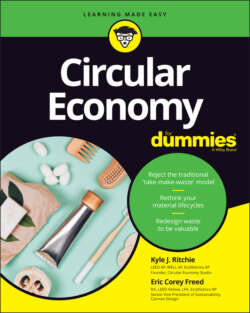Читать книгу Circular Economy For Dummies - Eric Corey Freed - Страница 68
Environmental, social, and corporate governance
ОглавлениеEnvironmental, social, and corporate governance (ESG) refers to a group of standards used by companies to monitor, track, and evaluate their performance in relation to their impact on the environment, society, and equity. They’re also used by socially conscious investors to evaluate and track their investments.
The simple idea behind ESG standards is that a business should be measured by more than just its financial performance. Basic business decisions made for financial reasons alone ignore how that company performs in relation to society as a whole.
Investors have taken notice. Companies embracing ESG standards often outperform their traditional competitors. In fact, those companies using a circular model typically deliver even better returns — and with lower risk.
According to Deutsche Bank, 95 percent of assets under its management (around $130 trillion) will be governed by ESG compliance standards by 2030. These compliance standards are a form of corporate transparency, where companies publicly disclose their progress toward meeting these environmental targets.
The benefit of ESG standards is that they provide a standardized approach to metrics and terms so that everyone can compare companies equally and hold them accountable for their progress toward their ESG commitments.
This list describes some ESG standards (and investment funds) related to the circular economy:
BlackRock (
www.blackrock.com): BlackRock has launched the BGF Circular Economy Fund, which aims to drive investment in businesses already benefiting from, or contributing to, the transition to a circular economy.European Commission (
https://ec.europa.eu): The commission has created the EU Taxonomy for Sustainable Activities to create the first green list of sustainable economic indicators.Circulytics Indicators: Developed by the Ellen MacArthur Foundation (
www.ellenmacarthurfoundation.org) in coordination with dozens of partners, these indicators are part of a comprehensive circularity measurement tool for companies.Material Circularity Indicators (MCIs): Developed by the Ellen MacArthur Foundation and Granta Design (now Ansys Granta,
www.ansys.com/products/materials), this tool lets companies identify additional circular value from their products and materials as well as mitigate risks from material price volatility.Circular Transition Indicators: Developed by the World Business Council for Sustainable Development (
www.wbcsd.org), this framework can be applied to all industries and companies to help them transition to a circular economy.
